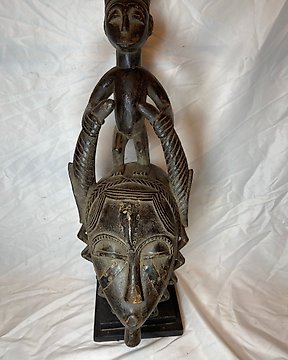
Masque - masque de danse baoulé - Côte d'Ivoire (Sans Prix de Réserve)
Nº 84041959

Nº 84041959

A Bete mask, Ivory Coast, of expressive features, half open mouth, protruding lips, stout nose, two coffee bean eyes slit at their center, bulging forehead, diagonal scarifications on the cheeks, the rims of the mask are punctured with holes ; glossy by use, cracks on the lips, thick encrusted patina, signs of use.
"Amongst the people known by the ethnonym of Bete – a term which encompasses several very different groups – it is only the western Bete, who live in western Côte d’Ivoire near the We and Nyabwa, who use masks of this type. Boyer states that the form “circulated [his emphasis] among these three ethnic groups” (Alain-Michel Boyer, We, Milan, 2019, p. 111) and that it was borrowed by the Bete from the Nyabwa. Boyer notes that “Nyabwa is the ceremonial language of the Bete for this mask” (ibid.), and that “Among the Bete, officiants use only Nyabwa so as to preserve the ‘authenticity’ of the ceremony” (ibid., p. 54; citing Marie-Noël Verger-Fèvre in Jean-Paul Barbier, ed., Arts de la Côte d’Ivoire, Geneva, 1993, Vol. II, p. 90).
In Boyer’s reading, all “distinction between the masks of the Eastern We, the Nyabwa and the Bete is artificial, since the brotherhoods that manage them are not curtailed by ethnic or dialectal barriers and readily perform in each other’s villages.” (ibid., p. 55). He continues, however, by noting that “amongst the Eastern We as well as the Western Bete, [masks] are commonly characterized by their majesty, their opulence […and] density of composition, multiplication of overlapping, stylized horns and tusks reaching out to the light in a constructed architecture, nostrils so hypertrophied that they sometimes resemble fins, sometimes the snout of a warthog curving up to the temples […]” (ibid.)."
Source: Sothe by's
Comment acheter sur Catawiki ?
1. Découvrez des objets d’exception
2. Faites la meilleure offre
3. Effectuez un paiement sécurisé